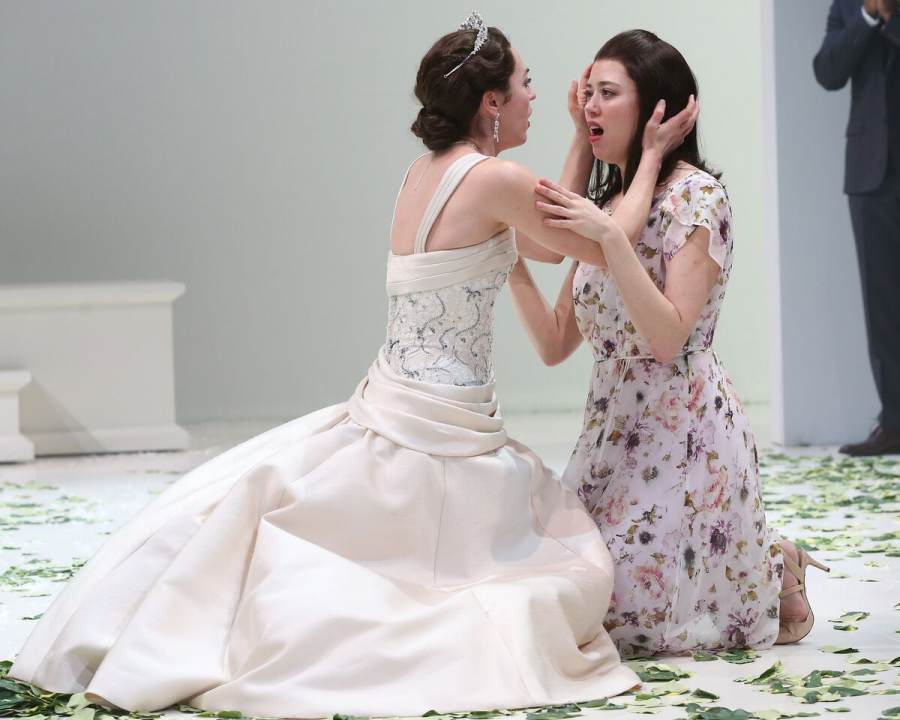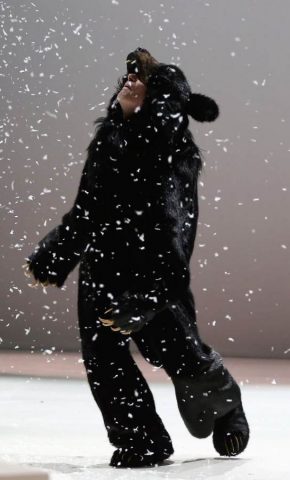

Arin Arbus doesn't beat around the bush in her production of Shakespeare's tragicomedy The Winter's Tale (at Theatre for a New Audience's Polonksy Shakespeare Center). She knows many of us are going to be waiting for that bear to show up in Act III and pursue Antigonus off in the most famous stage direction ever given.
So what does Arbus do? She gives us the bear right upfront. The production's very first moments feature Arnie Burton (who, interestingly, also plays Autolycus) clambering onstage in full bear costume and proceeding to revel in the falling snow.
It's a smart move for several reasons. It means we won't be holding our breath waiting to see what the bear looks like all through Acts I and II, and it ensures that the costume isn't just thrown away on a few seconds of stage time.
But, slyly, it's also artistic: we watch the bear pass from experimenting with the snow, to dancing in it, to freezing in it, and then climbing down into his hole (a trap door in the stage), presumably to hibernate until his big stage direction. It's another subtle nod to the theme of the play: metamorphosis, death and rebirth, winter and summer, lost and found.
Purists can rest easy, though: aside from that added bear scene at the beginning (and one or two comic ad libs from Autolycus), the production stays true to form, preserving almost the entirety of Shakespeare's original text. More importantly, Arbus' direction preserves the spirit of the work: quietly brimming with wonder.
With falling snow in the first half of the play and falling leaves in the second, the set is minimalist in flavor but magical in mood: its massive white archway standing as another symbol of transformational journeys. And thanks to Emily Rebholz's beautiful costumes - modern with a tiny flair of fancy - the stage doesn't often feel bare.

After that Act III stage direction, the most famous moment in The Winter's Tale is the statue scene; and here, both the dynamic cast and Arbus' inspired direction are at their very best. Up to this point, we've run the gamut from tragic sequences - played to great effect by Kelley Curran's strong-voiced Hermione and Anatol Yusef's tyrannical then broken Leontes - to tender scenes of young love played by a charming Eddie Ray Jackson as Prince Florizel and a royally lovely Nicole Rodenburg as Perdita. Meanwhile, Ed Malone's Clown and John Keating's Old Shepherd deserve (and get) the heartiest laughs of the evening.
But nothing compares to the emotional power of this final scene: choreographed and acted with such beauty and sensitivity that a hush falls over the audience and never lifts until the final few seconds of the play, at which point I heard several people (myself included) react with tenderness. When such a delicate scene is carried off with such wonderful effect, it deserves high praise, indeed. In short, you're not likely to see a more lovely, more faithful, or more magical production of Shakespeare's great transformation play.